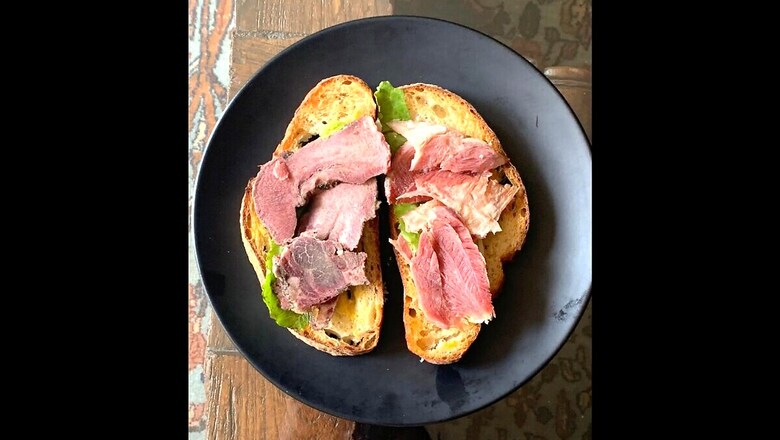
views
So, during these days of forced desolation and seclusion, I’d spend hours swiping through pages and pages of Zomato and Swiggy and just order in, or happily live off the munificence of neighbours, friends, home-chefs and restaurateurs, some who felt bad for me, some who honestly wanted my opinion, some who hoped for a plug and some who needed a guinea pig. On other days, there would be ham.
Know Your Ham
One thing my mother taught me when I first moved out of her home a couple of decades ago was: my fridge must always have eggs and freezer should forever be full of cold cuts. Ham, sausages, salami, luncheon meat, at least. If there was nothing else to eat in the house, you could always fry an egg and defrost some of that meat and make a sandwich or just eat it as it is. Even as a child, I remember our freezer was always stuffed with cold cuts. Small bags of sausages in assorted sizes, meatloaf, bacon, ham and salami in a variety of shades of pink.
Today eating cold cuts may be widely popular, but back then there were just a few Parsis, Christians and Anglo-Indians who savoured charcuterie. In fact, cold salads with ham and salami were strict etiquette at most parties then. Little canapés with chopped ham and pineapples or small crumbly savoury biscuits called sablés topped with a paste of ham and butter, moved around the room as effortlessly as ladies in chiffon. At home, my grandmother made the most delicious sandwiches with luncheon meat or salami, smothered in Polson butter and grainy home-made mustard, which were the centre of attraction when I’d open my little box at break-time in school. There was always a mini delicatessen in our freezer, but out of all the deli meats or cured meats, ham will always be my favourite.
ALSO READ | What The Fork: Who Invented Chicken Manchurian, Indians or Chinese? Kunal Vijayakar Has the Answer
Ham is a cut of pork from the hind leg that has been preserved by either curing or smoking. The history of preserving meats and ham goes back centuries. Some of the earliest methods of preserving meats for sustenance were through drying, smoking and curing and that is what gives ham its salty, substantial smouldering flavour. Weather also plays a significant role in the making of ham. That is why the best ham comes from what is called “The Ham Belt”.
The Ham Belt actually refers to a temperate climate zone bound by latitude across the world that is ideal for making good ham. This weather zone includes most of China, large swathes of eastern and central Europe, and in the United States covers Tennessee and Kentucky and Virginia, North Carolina, West Virginia, and Missouri. These lands that experience mild winters and hot, humid summers are historically known to produce the world’s most revered ham.
Gourmet Hams & Gourmet Cooking
Of course, in the days when I was a young boy in Mumbai, our cold cuts came from two or three cold storages. There was Café Galleries at one end of Breach Candy and Great Eastern Stores at the other and there was Francoise Maison up Cumballa Hill and Shalimar and Farm Products right next to each other. As kids we’d eagerly watch large blocks of ham, luncheon meat and long sausages of salami being sliced on a shiny rotating meat slicer, the portions then wrapped in thin plastic or butter paper, only after the jolly and ruddy Irani charcutier handed us a few slivers to taste.
But today, you can buy a variety of gourmet ham, imported and local, at large stores like Nature’s Basket and Foodhall. Depending upon what has been imported, you may be lucky enough to find a variety of different hams, each with their individual character and origins. Like Prosciutto. A salted, air dried, uncooked ham from Italy. Actually, Prosciutto is the Italian word for ham and Italian hams are often named according to their place of origin. The most renowned being ‘prosciutto di Parma’ or Parma ham, usually salted and air dried for between eight months and two years. It’s a salty, thinly sliced, dark red, leathery ham that goes well with a buttered hard baguette.
Then from France come two great hams, Jambon de Bayonne and Jambon de Paris. Jambon means ham in French and Jambon de Bayonne is a dry-cured ham which originates from the Basque region while Jambon de Paris is a ham that is slowly cooked in its own juice and wrapped in its skin, to keep its aroma and character intact, giving it a mild delicate flavour unlike a typical cured ham.
ALSO READ | What The Fork: How Kunal Vijayakar, Who Grew up in a Fish-eating Family, Fell for the Humble Chicken
You often see Black Forest Ham on the cold cases in our Mumbai gourmet stores. Black Forest Ham gets its name from the Black Forest area of Germany where it was first produced. This ham is originally salted and seasoned with juniper berries, coriander, pepper and garlic before being cured and cold smoked, and makes great sandwich ham. Jamón Serrano, a Spanish dry-cured ham, is the crowning glory of Spanish cuisine and is used a lot while making paella or tapas.
Closer home, I root for Honey Glazed Ham. Basted with a dash of pineapple juice and a buttery sticky glaze, a good Honey Baked Ham is moist and luscious on the inside, crispy and charred with sticky edges on the outside. When you cut a thick slice, you get a juicy piece of meat exploding with the saltiness from the ham, the sweetness of the glaze and the smokiness of the cooking. Mrs Rocha, my friendly neighbourhood cold storage owner, makes a divine Honey Glazed Ham every other day and sells it at Farm Products in portions.
But ham is not just a cold cut or a breakfast meat, it can be an integral part of gourmet cooking. One of France’s national delight is the Croque monsieur, a gourmet sandwich made with soft sourdough, Gruyère, smoked ham béchamel sauce and grilled. A buttery, cheesy, melty and crisp ham sandwich. Or, a Ham Cordon Bleu. Thin slices of ham wrapped around cheese (or with cheese filling), breaded and fried till golden and crunchy. Even a Ham Braciole. In Italy, a braciole or Involtini di Manzo, (involtini meaning “little bundles), is a piece of very thin meat (beef, chicken, ham and in Sicily, even fish) with a filling of bread crumbs, herbs, garlic, cheese or pancetta, pine nuts and raisin, tied up into small bundles, cooked in a slow simmering tomato sauce, and finished off with a classic lemon, garlic and parsley gremolata.
For me, nothing is as warming as a hot green pea and ham soup with chunky croutons, ham, corn and cheese au gratin or just a cold thick slice of Honey Glazed Ham on warm buttered toast. In fact, when I animatedly start discussing my love for ham, and my face lights up and my voice gets louder, my friends often look at me and say, “What a bloody ham!”
Read all the Latest News, Breaking News and Coronavirus News here.




















Comments
0 comment